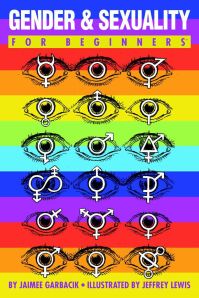Summary of Introduction
Jaimee Garbacik, the author of Gender and Sexuality for Beginners, introduces this book by discussing what she and young people find is the current “most pressing issue of our time” (Garbacik, 1). She claims that the array of answers is due to a discrepancy in gender. This discrepancy is due to the current language and use of categories of genders in which many cases, some people do not fit under. One of Jaimee’s biggest concerns is how this affects young people. Adult’s rules and policies are hindering young people’s livelihoods to the point where many don’t see a happy future and commit suicide. “In fact, 30 percent of lesbian, gay, and bisexual youths attempt suicide between the age of fifteen and twenty-four (Garbacik, 2). Throughout the introduction, Jaimee discusses the issues of categorizing this fight under one name and the complications even people apart of specific communities like LGBTQIA or feminism face. The most important people can do is not only support the youth, but learn from them. The purpose of this book is to educate the reader about the current “discriminations in our society that limit every citizen’s aptitude and personal expression” (Garbacik, 5). All in all, this introduction provides the basis for what reader’s should anticipate in future chapters, and what the writer, Jaimee Garbacik, expects, and hopes, for the reader to gain.
The Rhetorical Situation:
- The rhetorical situation that Garbacik is responding to is the issue of people’s understanding of gender and sexuality in our societies. In particularly, adult’s lack of wanting to learn from the young people. Through young people, society can diminish the barriers of labels. The main audience for this book, in my eyes, are the people that are aware of the issues, but may not fully know the how to digest or take action on the given information. The purpose of this book is for readers to finish the book understanding how their actions and assumptions impact other human beings. Readers should expect to learn lexicon, motivation to dig deeper for information, and to further educate and spread the awareness of this topic.
The Rhetorical Strategies:
- Throughout the introduction, Jaimee reveals her personal investments, establishes her qualifications, or lack of, acknowledges her sources, and even articulates the audience this book is intended for. She is able to support her claims and facts from gathering information through interviews with various communities, reflecting on her personal experiences, and providing strong and emotional statistics. Her ability to be rhetorically aware of her audience, people who are ill informed on the issues as well as people apart of the LGBTQIA community and numerous other communities, is apparent in her writing due to her ability to look and understand different stances individual’s stand by.
The “Writer’s Identity”:
- Garbacik takes on a strong identity in this book. She immediately presents herself as someone an audience can trust by providing factual situations that have occurred in our society, as well as meaningful and emotional statics that show how prevalent this issue truly is today. Even better, she fully understands the importance of knowing how to communicate with different communities, a concept that was presented in the book, Understanding Rhetoric. While reading this introduction, I felt that she was conveying a message to two audiences. The first audience is the uniformed people, in particularly many adults. The second audience is the young people, regardless of them knowing a little or a lot about the complicated issues about to be discussed. With this in mind, Garbacik knows when and what it is appropriate to say at the right time. BY combining all of these concepts, Garbacik is allowed to express her concerns, ideas, and vision of the future in a credible way that will permit a reader to gain awareness on the issues centered around gender and sexuality.
